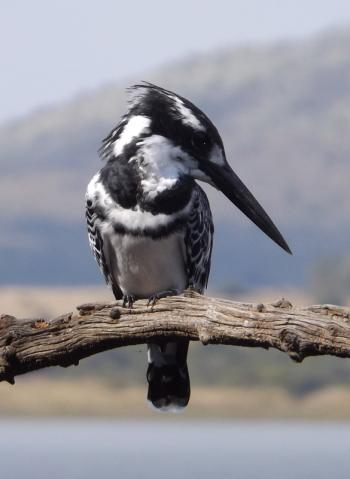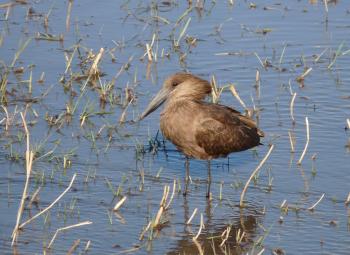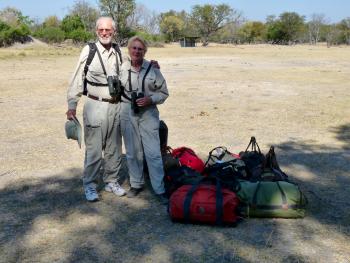A good bird-watching site
Subscribers were invited to write in about places, outside of the US, where they've had rewarding sightings of birds. (We cannot accept more submissions.)
In addition to the types of birds they saw, we asked travelers to each tell us where they were and the year/month/time their visit took place. We also wanted to know how difficult it was to reach an area, what equipment would be recommended and what the weather was like.
We printed responses about sites in Latin America in the last three issues. This month, we're in Africa.
Friends my husband, Al, and I were visiting in SOUTH AFRICA in April 2013 took us to Pilanesberg National Park, about three hours northwest of Johannesburg.
It was a beautiful fall day, with the temperature in the 70s. The drive there was on excellent roads, and we soon arrived at the gate and paid our entry fees of ZAR40 (about $3) for a vehicle and ZAR80 per person.
The park is set within the crater of an ancient volcano, is malaria-free and features the Big Five. However, we were most interested in the birds. Up to 360 species have been spotted within the park, and there are six bird hides facing different directions — ideal for serious bird-watchers.
We chose the Mankwe hide, situated on a large body of water and reached by a raised walkway. It was our great fortune that a serious birder was there with a big bird-identification book. She pointed out the birds to me, identifying each one as I snapped pictures.
The roofed hide had tables and benches, and we planned to eat our picnic lunch there, but taking pictures and writing down the names of birds kept me too busy to eat.
We saw many varieties, including the pied kingfisher, fish eagle, woolly-necked stork, African jacana, little grebe, Egyptian goose, crested francolin, hamerkop and many others.
A few dead trees in the foreground were popular amongst the birds and provided a wonderful "prop" for photographs. It was an exciting afternoon!
Pilanesberg also has a walk-in aviary of indigenous birds, but we didn't go there; it's more of a challenge to see the birds in the wild.
Emily Moore
Greenville, IL
I went to SOUTH AFRICA, Victoria Falls and the Chobe National Park area of BOTSWANA in early June 2013 on an independent trip arranged by Africa 2000 (P.O. Box 1025, Knysna 6570, South Africa; phone +27 44 382 5845, www.africa2000tours.co.za), a company I heartily recommend to anyone considering a trip to Southern Africa.
I had never been particularly aware of birds in the past, but there were such beautiful birds where we toured that I have since become an avid amateur bird photographer.
My favorite bird in Southern Africa was the lilac-breasted roller. Its feathers are lilac around the throat and breast, bright green on the head and lower body and blue and gold on the wings. Just amazing! We saw this bird in Chobe National Park.
The Chobe River attracts many birds. We saw an African darter dive into the river and catch a fish.
Helen W. Melman
Los Angeles, CA
We are avid birders, and in August 2016 we took a fabulously rewarding bird-watching tour to Namibia and Botswana. We traveled with Victor Emanuel Nature Tours (Austin, TX; 800/328-8368, ventbird.com), which exclusively runs birding tours.
In NAMIBIA, we visited Etosha National Park, where we stayed at Andersson's Camp (phone +264 83 330 3920, www.ongava.com/anderssons-camp), birding inside the park each day.
In BOTSWANA, while in the Okavango Delta, we stayed at Nxamaseri Island Lodge (A35 Maun-Shakawe, Ncamasere, Botswana; phone +267 71 326 619, www.nxamaseri.com), where we birded both on land and from small skiffs in the delta floodwaters.
For most of the group, the highlight of the trip occurred there when we had good looks at the Pel's fishing owl, one of the largest owls in Africa, measuring up to 60 inches in wingspan and weighing around 5 pounds. Rusty brown in color, it fishes at night, but we were lucky enough to spot one roosting in a tall jackalberry tree.
Overall, on our 15-day trip, we saw 315 species of which 85 were new to us. Naturally, we saw big game as well — elephants, rhinos, giraffes, zebras, klipspringers, hyenas, hippos, buffaloes and gnus, to mention a few. When you are out at dawn, or sitting quietly in a skiff on a river looking for birds, the game also come by.
Linda & Peter Beuret
Santa Barbara, CA
I saw many birds in the Djoudj National Bird Sanctuary in SENEGAL on a tour with Adventures Abroad (Blaine, WA; 800/665-3998, www.adventures-abroad.com).
It's rather a remote area, and I think it would be a bit hard to make all the arrangements on your own. (You need to be in a boat to see the birds.)
This was in February 2011, and the weather was perfect — warm and sunny. Our small tour group of about 14 people was there midmorning, 10 to 11 a.m. The birds were abundant, and the boat could get quite close to them.
I was able to take good pictures with my Nikon camera equipped with a 22x zoom lens. No tripod was necessary, and, as the boats were relatively small, it would have been unusable anyway.
Djoudj is a pelican-breeding ground, and there were over a hundred of these birds in the area.
Gordon W. Draper
Livonia, MI
My husband and I flew via light plane into Shoebill Island Camp* in the Bangweulu Wetlands in northern ZAMBIA in May 2007. We went for the great birding opportunity, particularly to see the very strange-looking shoebill bird. It stands about 4 feet tall, has a very large beak and looks like it is always having a bad-hair day.
The birds nest on the ground, normally with two or three eggs, and are mainly fish eaters.
I had no trouble getting pictures, as the shoebills remained relatively static either on the ground or up high in the trees. We reached them by small boat and were lucky to see eight to 10 of them. Even hopping out of the boat into the water to get better pictures did not seem to bother them.
Anne Warburton
Yorba Linda, CA
*Shoebill Island Camp is no longer in operation.
For two days of birding prior to a tour of Uganda, my wife, Lorelyn, and I made arrangements with Avian Safaris (Zana, Entebbe Rd., Plot 526, P.O Box 71335, Clock Tower, Kampala, Uganda; phone +256 782 475 961, www.aviansafaris.com). We arrived in Entebbe on Sept. 29, 2012.
Our guide, Crammy Wanyama, picked us up at our hotel at 6:30 a.m., and we ended up driving on a dirt road for several miles and then walking up a dirt driveway, where we spotted a Ross's turaco.
When the owners of the property walked down the driveway, Crammy met them halfway. He returned with a smile, saying that, seeing our cameras, they had thought we were government officials there to take their property.
Our next stop was the Lutembe Bay wetlands, followed by Lake Victoria for shorebirds and, at 3 p.m., a short drive to the Entebbe Botanical Gardens. By 6 p.m. we had logged 102 species for the day.
The next day we added 56 more species after making a 90-minute drive to the Mabamba Bay wetlands, south of Entebbe on Lake Victoria. Crammy arranged for a canoe and a sighting guide, David, an expert who could locate specific species of birds.
Number one on the list — a shoebill stork (Balaeniceps rex), a massive, bulky bird 4 feet tall, with only 5,000 to 8,000 individuals remaining. Crammy and David spotted three, and we got close enough to hear the wings scooping large quantities of air on takeoff. Watching the takeoff reminded me of a C-17 Globemaster lumbering into flight.
•
A visit to a colony of southern carmine bee-eaters (Merops nubicoides) in NAMIBIA's eastern Caprivi Strip capped off our fourth African trip with guide Darryl Tiran (phone +263 13 42996, www.vicfallsguide.com).
These bee-eaters arrive at their breeding grounds during August or September, and Darryl arranged for a boat to pick us up at Mubala Lodge on Sept. 22, 2017.
After a 25-minute high-speed run on the Zambezi River, the three of us scrambled up a 20-foot bank of soft river sand. As we crested the bank, hundreds of southern carmine bee-eaters appeared in camera range. This colony was nesting on a level area of sand above the river, while other colonies nested in tunnels that they excavated along the riverbank.
Southern carmine bee-eaters are the largest of the Southern African bee-eaters — 10 inches long plus a 4½-inch tail. The bird's body is two shades of red, with a dark-turquoise crown and forehead, pale-blue vent and rump and a black stripe from the bill to behind the eye.
Breeding season always brings a high level of activity, with males showing off, paired couples scraping out a divot in the soft sand, and others collecting small twigs and grass for nests. It was a most memorable day.
Birding over two days in the Caprivi Strip of Namibia and along the Chobe River in Botswana produced sightings of 181 species.
Fred Koehler
Orange, CA
Next month, birds in Australia.



